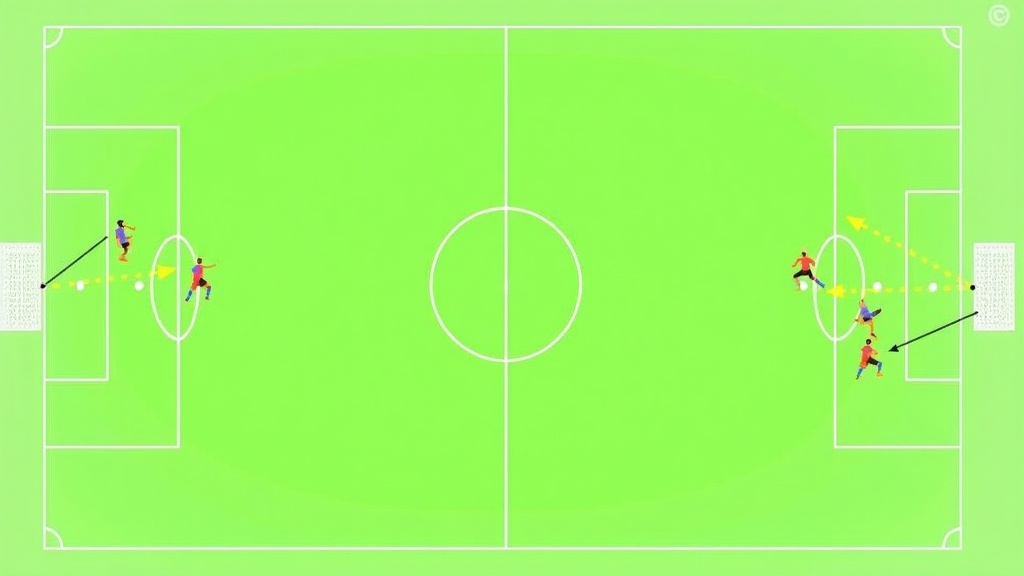 Locking down your end of the field in soccer takes more than just fast feet and tackling skills. A solid defense is what keeps your team in every match, especially when the pressure cranks up. If you’ve ever watched a great defensive unit in action, you know it relies on teamwork, smart positioning, and a ton of communication. It’s far more than just clearing balls out of danger.
Locking down your end of the field in soccer takes more than just fast feet and tackling skills. A solid defense is what keeps your team in every match, especially when the pressure cranks up. If you’ve ever watched a great defensive unit in action, you know it relies on teamwork, smart positioning, and a ton of communication. It’s far more than just clearing balls out of danger.
Soccer players and coaches are always searching for ways to make their defenses tougher to break down. The truth is, some simple habits and rules can make a big difference in how any team holds the line. Whether you’re coaching kids or playing in an adult league, these guidelines can really help your team hold strong together and frustrate even the most skilled attackers. Solid defense builds confidence and helps players experience real enjoyment in the game, as every stop matters. If you take defending seriously, it spills over into every aspect of your team’s mindset.
This article breaks down 10 golden rules I’ve picked up or seen win matches over the years. These rules make building an almost impenetrable defense in soccer much easier for any squad, no matter the level. Time to roll and see how you can make your team harder to break down, whether on a big stage or your local field. CHECK OUT : LEARN HOW TO DO WORK FROM HOME
1. Stay Compact: No Gaps, No Gifts
The easiest path to goal for any attacker is through open spaces between defenders. Keeping your back line and midfielders close together in a compact shape cuts off lanes that strikers love to exploit. When your lines move as a unit, it becomes much tougher for the attacking team to play passes through or around you.
How to do it:
- Keep defenders and midfielders no more than a few yards apart, both horizontally and vertically.
- Shift together whenever the ball moves side to side.
- Collapse quickly toward your own goal if the other team breaks through the midfield.
Teams that keep it compact are more resilient, even under pressure. By closing up those spaces, you force opponents to try more difficult passes and creative plays, which lowers their scoring chances significantly. Over time, your squad will find that compactness saves energy and makes defending less chaotic.
2. Communication is Key; Talk Constantly
Silent defenses don’t work well. Great back lines are loud, always giving each other info: “man on,” “step up,” “cover left.” The goalkeeper often leads the talking, but every defender helps out. Communication keeps everyone aware, organized, and ready to react. Don’t be shy to use your voice, as it can prevent simple mistakes and ensure everyone handles their job.
- Call out opponents making runs and alert teammates to dangers.
- Let teammates know who has the ball or who’s stepping out.
- Encourage each other, especially in stressful moments.
When your team gets chatty in the right way, mistakes and confusion drop quickly. Players who communicate create trust, and that’s what solid defense needs. If you make talking a habit, you’ll notice more confidence in your back line every game.
3. Win Your OneonOne Battles
No matter how well organized your team is, every defender finds themselves going head to head with an opponent at some point. Winning those duels starts with good footwork, strong body position, and determination. Sometimes it’s just about not making things easy, or buying time for teammates to get organized behind you. This oneonone spirit often decides the outcome in tight matches and separates great defenders from average ones.
A few quick tips:
- Force attackers away from goal, not toward it.
- Stay on your feet; don’t dive in unless you’re sure you’ll win the ball.
- Use your body to shield and jockey, rather than always trying to tackle.
Confidence here comes with practice and from supportive teammates right behind you. Focus on staying balanced and keeping your eyes on the attacker’s waist—it’s the best way to react quickly if they try to fake or trick you.
4. Master the Art of Positioning
Being in the right spot at the right time saves legs and prevents lots of trouble. Good positioning lets defenders cut out passing lanes, intercept balls, and always be first to loose balls. It also means less running around frantically when the other team is attacking. Often, one simple adjustment keeps your team out of risky situations.
- Stay goalside (between your opponent and your goal).
- Keep an open body stance, watching both the ball and any runners.
- Know when to step up and when to drop back, depending on where the ball and pressure are.
Proper positioning takes some time to learn, but it pays huge dividends in game situations. Watch professional defenders—they move smoothly, rarely sprinting needlessly, all thanks to their sharp positioning skills.
5. Track Runners; Don’t Ball Watch
Attackers often score because defenders drift toward the ball and lose track of players sneaking in behind. Smart defenders check their surroundings and make sure no one slips away, especially in and around the box. One slip in focus can decide a match, so keeping sharp is essential.
- Glance over your shoulder regularly, especially when the ball is out wide.
- Stay tuned into both the ball and possible runs behind you.
This habit prevents those tap-in goals that leave everyone frustrated after the game. Make it your mission to track your mark at all times and help your teammates with heads up calls.
6. Set Traps: Use the Sidelines and Offside Rule
Defending smart isn’t just reacting; it’s about forcing attackers where you want them. Defenders can use the sidelines as an extra teammate, guiding attackers away from dangerous areas. Coordinated back lines can also step up together to catch opponents offside, as long as timing is sharp and everyone’s on the same page.
- Angle your body to shepherd attackers towards the line.
- Work with your teammates to step up together when the chance is there for an offside trap.
Pulling off a perfectly timed offside trap feels awesome and can really frustrate opposing forwards. It’s a risky play, but with good teamwork and trust, it becomes a powerful tool for any defensive line.
7. Defend as a Team; Everyone Has a Role
No defense works without everyone pitching in, especially midfielders. The first line of defense is often your forwards and midfielders slowing down the ball or blocking passing lanes. When the whole team defends, it’s much harder to break open the back line with one pass or dribble. True teamwork starts up front and rolls all the way back to the goalkeeper.
- The first defender pressures the ball, while others cover options or space.
- Midfielders must track back quickly and plug any holes that open up.
I always enjoy seeing teams where even strikers hustle back and make life tough for opponents. Real team defending makes the difference between average and tough to beat squads. Team spirit counts for a lot, and defending together shows just how much your group cares about each other’s efforts.
8. Clear the Danger Smartly
Panic clears rarely go well; just booting the ball out is not always the answer. Defenders do themselves a favor when they stay calm and look to clear the ball wide or even pick out a teammate if there’s time. Aimless clearances can put your team right back under pressure.
- Head or kick the ball out toward the sidelines first.
- Try to clear to an open teammate for a quick counter when safe.
- If in doubt, get the ball as far from the danger zone as you can.
Making clearances purposeful helps keep your defense from scrambling. Practice this during training by focusing on lifting your head before you clear and understanding where your teammates are likely to be even when under pressure.
9. Stay Disciplined; Avoid Rash Tackles and Fouls
It’s so tempting to make a risky challenge when you’re under pressure, but mistimed tackles lead to penalties, dangerous free kicks, or even a red card. Discipline is about patience and trusting teammates to help out, rather than lunging in or pulling down a shirt out of frustration.
- Slow attackers down, but don’t commit unless you’re confident.
- Hold your position and block shots or crosses instead of always trying to win the ball.
Keeping your cool really matters. Referees often spot players who stay calm and act with patience, giving your team a reputation for classy defending. Take pride in not giving up avoidable fouls—this helps keep your team safe in crucial moments.
10. Adjust Quickly; React to the Situation
No two games (or even two attacks) are the same. The best defenders are ready to change up the line’s height, formation, or marking style on the fly. Maybe you drop deeper late in a close game, or maybe you press higher when chasing an equalizer. Reading the flow and adapting is what sets solid defenses apart from those that get exposed late on.
- Talk through changes as a unit when situations switch up.
- Trust your instincts; if something isn’t working, adjust sooner rather than later.
The ability to read the game and change tactics or positioning at the right time shows real soccer intelligence. Being ready to adjust as a group—whether it’s moving up, falling back, or mixing up who marks who—helps forge an all-in-one and dependable defense.
Final Thoughts
A strong defense gives every team a real chance in every match. These rules aren’t just for pros; any player or coach can use them to make defending more solid and much less stressful. Trying out even a couple can instantly make your team harder to break down, and good defensive habits become second nature the more you practice them.
Which of these defensive tips will you work on first? I’d love to hear about your team’s defending adventure or your biggest back line victory. Drop your thoughts in the comments and share what works for you on the pitch!
